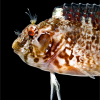Try adding a fish that's already adapted to eating flakes - something vaguely similar in behavior - a killie, gambusia, minnow ...
They often learn quicker from tankmates.
BTW - How's the Lyre goby population looking this year? The male you gave me in Nov 2014 died just recently. He'd looked great for about 18 months, then started getting thin the past couple months. Saved him for NCSM collection. Have you figured out yet whether they reproduce and grow in that pond, or rely on continuous recruitment from the estuary?
I have a tank full of gambusia, and will add some after work. They definitely have no problems eating!
That pond unfortunately has been changed to the point of being unrecognizable. DOT came in and added some floating vegetation mats, the kind that eventually secure themselves via plant roots. They also added some solar powered air pumps, which initially removed most of the cyano, and really cleared the water up. About 4 months later, this aquatic plant that was for years only covering about a 12" by 12" plot, took over and choked the entire pond. There may still be some gobies in there, but seining is now out of the question.
Fritz, Jesse, and I sampled the pond last December, both dipnetting and electrofishing. We managed a few freshwater gobies, about 9 river gobies, and a single lyre goby. I'm afraid they no longer call that place home. There is an adjacent creek however, and I have been catching female and juvenile lyres in there pretty frequently lately, but no pretty males like you had!










